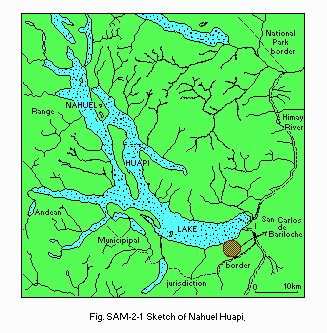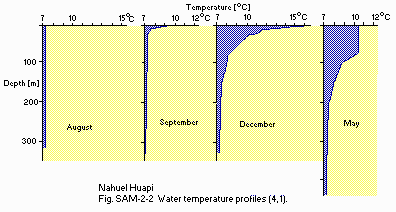LAGO NAHUEL HUAPI (LAKE NAHUEL HUAPI)
A bird-eye view of the lake
Photo: I.R.Wais-Badgen
A. LOCATION
- Rio Negro Province, Argentina.
- 40:40-41:10S, 71:10-71:50W; 740-767 m above sea level.
B. DESCRIPTION
-
Nahuel Huapi is a glacial lake located along the eastern slope of Southern Andean Range with a maximum length of 67 km and a maximum width of 10 km. The lake resembles in its shape "a gigantic amoeba with enormous tentacles extending in all directions to form (1)" a number of arms or fjords. It is also encircled by many smaller lakes. Mountains fringe almost all its coastline; there is a succession of bays and coves, shingle and sandy beaches, perpendicular rocky cliffs, steep promontories, and wooded isthmuses and peninsulas.
The lake offers one of the nicest landscapes in South America, and has been included since 1909 in Nahuel Huapi National Park, the largest of Argentine national parks (785,000 ha). The international city of San Carlos de Bariloche, growing up very fast on the southeastern margin of the lake, attracts every year lots of tourists with pleasant summer weather and winter sports.
The report of a Swedish South-American expedition in 1953-1954 (1) states that "the luxuriant forests of Austrocedrus and Nothofagus surrounding its solitary fjords contrast with the scanty aquatic macrophytes" and that "the scarcity of the latter is partly dependent on the very limited shallow water areas..." This situation, however, changed in the last years when a rapid cultural eutrophication was observed in some small and less deep inlets of the lake, particularly near the city of Bariloche, though the main body of Nahuel Huapi remains oligotrophic. Thus, a lot of macrophytes, especially Scirpus californicus, cover those inlets and are expanding in some arms. Those arms are also rich in nutrients and phytoplankton owing to the result of human activities. Protective measures should be taken before the eutrophication and other kinds of pollution spoil the value of the National Park, where the municipal authorities of Bariloche have jurisdiction of administration (Q).
C. PHYSICAL DIMENSIONS (1)
| Surface area [km2] | 646 |
| Maximum depth [m] | <300 |
| Water level | Unregulated |
| Length of shoreline [km] | 357 |
| Catchment area [km2] | 2,758 |
D. PHYSIOGRAPHIC FEATURES
D1 GEOGRAPHICAL (Q)- Sketch map: Fig. SAM-02-01.

Sketch map of the lake.
- Names of main islands: Victoria.
- Number of outflowing rivers and channels (name)
1 (Himay R., belonging to Rio Negro system draining into the Atlantic Ocean).
- Climatic data
Precipitation [mm] ). * Western side of the lake.
- Water temperature: Fig. SAM-02-02.

Water temperature profiles [deg C](4, 1).
- Freezing period: None.
- Mixing type: Monomictic. Occasionally holomictic.
- Notes on water mixing and thermocline formation
Nahuel Huapi is a subtropical lake, in which the overturn takes place throughout entire depths once a year in winter (July-August). The summer stratification is well developed and the temperature of hypolimnion is 7-8deg C throughout the year (Q).
F. BIOLOGICAL FEATURES
F1 FLORA- Emerged macrophytes: Scirpus californicus, Isoetes savatieri (Q).
- Submerged macrophytes: Ceratophyllum demersum, Miriophyllum elatinoides (Q).
- Phytoplankton (5)
Winter-spring
Dictyosphaerium pulchellum, Melosira granulata
Summer-autumn
Rhizosolenia eriensis, Dinobryon divergens, D. cylindricum, Melosiragranulata.
- Zooplankton (5)
Rotatoria (Keratella cochlearis, Polyarthra vulgaris, Pompholyx sulcata, Filina longiseta, Gastropus stylifer); Copepoda (Boeckella gracilipes); Cladocera (Bosmina chilensis). - Benthos (Q)
Decapoda (Samastacus spinifrons, Aegla riolimayana); Amphipoda (Hyallela curvispina); Mollusca (Chilina puelcha, Ch. parchappei, Diplodon patagonicus); Oligochaeta (Chaetogaster limnaei, Stratiodrilus aeglophilus). - Fish (Q)
Percichthys trutta, P. colhuapiensis, Salmo trutta (introduced), S. gaudneri* (introduced), Diplomistes sp., Hatcheria sp., Aplochiton sp., Galaxias maculatus. * Economically important. - Supplementary notes (6, 7, 8, 9, 10, 11)
The biota of all the Andean Patagonic area is characterized by a high degree of endemism, at a species or genus level in some cases but even at a family level in others.
H. LAKE UTILIZATION
H1 LAKE UTILIZATION (Q)- Navigation and transportation, sightseeing and tourism, recreation (swimming, sport-fishing, yachting) and source of water.
- Domestic water and some industrial water.
I. DETERIORATION OF LAKE ENVIRONMENTS AND HAZARDS
I1 ENHANCED SILTATION (Q)- Extent of damage: None.
- Present status: Detected but not serious (?).
- Supplementary notes
There is still very poor information; serious studies as well as continued complete monitoring and assessment are lacking.
- Nuisance caused by eutrophication: Unusual algal bloom.
- Supplementary notes
Limited to small inlets near the city of Bariloche. Refer to B (Description).
- Extent of damage: None.
J. WASTEWATER TREATMENTS
J1 GENERATION OF POLLUTANTS IN THE CATCHMENT AREA- Limited pollution with wastewater treatment.
N. SOURCES OF DATA
- Questionnaire filled by Lic. Irene R. Wais-Badgen, Instituto Nacional de has Ciencias Naturales, Buenos Aires.
- Tomasson, K. (1959) Acta Phytogeogr. Suec., 42: 1-83.
- Ljungner, E. (1959) Nahuel Huapi. Uppsala Univ., Arsskr.
- Jefferson, M. (1921) The Rainfall of Chile. Amer. Geogr. Soc. Res. Ser. 7 (in Spanish).
- Cordini, I. R. (1939) Nahueal Huapi Lake. Bol. Direc. Min. Geol. B. Aires, 47 (in Spanish).
- Thomasson, K. (1963) Acta Phytogeogr. Suec., 47: 1-139.
- Wais, I. R. (1984) Ann. Limnol., 20 (1-2): 115-122.
- --- (1985) Verh. Intern. Verein Limnol., 22: 2167-2172.
- --- (1985) Com. Mus. Arg. Cienc. Nat. Hidrobiol., 2: 148-154 (in Spanish).
- --- (1986) Spheniscus, 4: 39-44 (in Spanish).
- --- (in press) Macrozoobenthos of Negro River basin, Argentine Patagonia. Stud. Neotrop. Fauna & Environ.
- --- (in press) Verh. Intern. Verein Limnol., 23.


